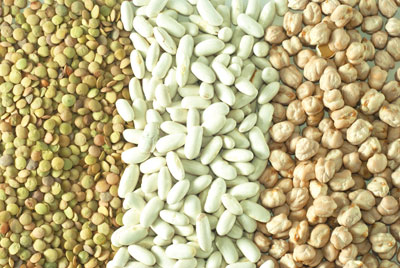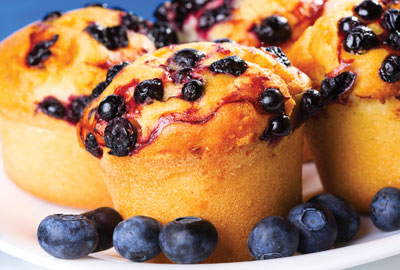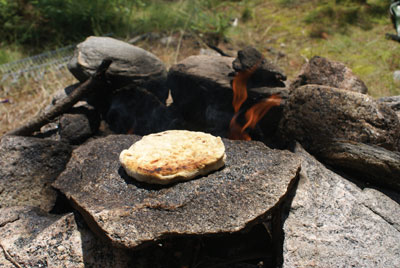
Canadian favourites
August 29, 2012
By
Stefanie Wallace
Canada’s multicultural population has brought a unique flair to our
cuisine, but there are some dishes that are distinctly Canadian.
Canada’s multicultural population has brought a unique flair to our cuisine, but there are some dishes that are distinctly Canadian. Each year we celebrate Canadian baking, but this year we’ve decided to find out what makes each province and territory famous by exploring local ingredients and specialties from coast to coast to coast.
 |
|
| Pulses, the edible seeds of legumes, are perfect for adding to baked goods for your gluten-free customers.
|
British Columbia
The cookie wafer base, flavoured butter icing and chocolate topping are a scrumptious combination only found in Nanaimo bars. This dessert is said to have originated in the 1950s in Ladysmith, Vancouver Island, south of Nanaimo, when a housewife named Mabel Jenkins submitted her recipe to the annual Ladysmith and Cowichan Women’s Institute Cookbook. The earliest confirmed printed copy of the Nanaimo bar recipe appears in His/Her Favourite Recipes, Compiled by the Women’s Association of the Brechin United Church, published in 1957, submitted by Joy Wilgress, a native of Baltimore, Md. It has since received national acclaim: a 2006 National Post reader survey deemed Nanaimo bars Canada’s favourite confection. The City of Nanaimo takes pride in this, with a special page of its website dedicated to the creamy, chocolaty treat, including a detailed guide of where to find different variations of Nanaimo bars in the city. From the traditional square bar to a Nanaimo bar cupcake, or a Nanaimo bar latte or martini, there’s surely a variety for everyone.
Alberta
While fresh fruit growers are plentiful in the west, Alberta will always be known for its beef. The province’s cattle industry dates back to the late 1800s. Today, 53 per cent of Alberta producers have beef cattle, and the province has 1.95 million breeding beef cows and heifers (39 per cent of the Canadian total). Alberta Beef Producers participates in community programs to inform Albertans about the benefits of beef, including educational initiatives to teach students about nutrition, environmental care and animal safety. Use Alberta beef to add some protein to your baked goods via classic comfort foods such as shepherd’s pie or tourtiere.
Saskatchewan
The city of Saskatoon got its name from the deciduous saskatoon shrub found mainly in the Prairies. But besides bearing a name for a city, the shrub bears saskatoon berries, a sweet, violet-coloured fruit perfect for jams, jellies and desserts. The city’s namesake shrub can also be found in the Northwest Territories, the Yukon, British Columbia and northwestern and north central United States. Fresh saskatoon berries – also known as serviceberries or juneberries – are available in Saskatchewan between mid-July and late August. The Saskat-chewan Fruit Growers Association offers several recipes for jams and sauces, but its Saskatoon Berry Dream Cake stands out among them. A fluffy white cake with a layer of fresh berries – the name says it all.
Manitoba
Manitoba is also known for its beef and pork, but let’s not forget about pulses. Pulse is the term for the edible seeds of a legume, including dry peas, beans, lentils, chickpeas and soybeans. They’re high in fibre and complex carbs, low in fat, and are a good source of folate. They’re also gluten free, and are great ingredients to incorporate into baked goods to accommodate gluten-free customers. The Manitoba Pulse Growers Association offers several recipes, including a gluten-free chocolate cake featuring a black bean puree that looks almost sinful.
Ontario
The butter tart has been called the quintessential Canadian dessert. Stories of origin vary, but the earliest documented recipe was found in the Women’s Auxiliary of the Royal Victoria Hospital Cookbook, printed in 1900 in Barrie, Ont. The fillings may vary, but the base recipe calls for butter, eggs and sugar in a pastry shell. Some traditional recipes have raisins or other dried fruits, and pecans or walnuts are common ingredients too. Butter tart enthusiasts in Wellington County have compiled the Butter Tart Trail, a list of shops and bakeries in the area that carry this tasty treat.
Quebec
Quebec offers several savoury meal staples, but La Belle Province is also home to many delightful delicacies. One highlight of Quebec cuisine is nougabricot, a preserve consisting of apricots, almonds and pistachios that’s perfect for spreading on pancakes or waffles or drizzling over ice cream. If confectionary goods are more your style, try your hand at making sucre à la crème, a traditional Québécois treat. Ingredients vary slightly from recipe to recipe: some call for just brown sugar, white sugar and heavy cream, and others include butter, maple syrup and vanilla extract. The concept is similar to fudge, but with a slightly granular texture that melts in your mouth.
New Brunswick
New Brunswick’s strong Acadian culture comes alive through the many traditional dishes the province is known for. Not to be confused with french fries covered with cheese curds and gravy, poutines à trou (also called poutine routies) are mouth-watering Acadian square pastries, filled with cranberries, raisins and apples and baked in the oven. Dessert was not traditionally served with Acadian meals, so this was considered a special treat, and is still considered the most delectable of Acadian desserts.
 |
|
| Nova Scotia’s wild blueberries are perfect for classic blueberry muffins.
|
Nova Scotia
Scallops, oysters, lobster . . . the list of popular seafood fare in Nova Scotia is endless. But the central region of Nova Scotia is known for wild blueberries. The province is the largest processor of wild blueberries in the world and the second largest on earth (second to Maine). The blueberry is Nova Scotia’s provincial berry and its antioxidant health benefits are abundant. Nova Scotia produces more than 40 million pounds of wild blueberries and the province’s wild blueberries are exported to several countries, including the United States, Japan, Germany and the United Kingdom. Van Dyk’s Health Juice Products in Queens County, N.S., produces pure wild blueberry juice perfect for incorporating into sauces and desserts, like its recipe for blueberry crème caramel. And of course, you can’t go wrong with a classic, old-fashioned wild blueberry muffin.
Newfoundland
Seal flipper pie is a unique dish from the Rock. The filling of this savoury meat pie is made of seal flippers, which are boiled and then baked with onions, then added to a dumpling pastry with vegetables. The pie is traditionally served at Easter, often with mashed potatoes and boiled cabbage or other greens. A customary dessert best follows a customary dish, and figgy duff, a traditional raisin pudding that’s boiled and served steaming hot, is the way to go.
 |
|
| Potatoes are a staple in Prince Edward Island, and the secret to keeping scones moist and delicious.
|
Prince Edward Island
Prince Edward Island is, without a doubt, potato country. The starchy vegetable has been farmed in P.E.I. since 1790, and potatoes are the province’s primary cash crop, according to the Prince Edward Island Potato Board. The Island is Canada’s leading potato province, responsible for nearly a third of Canadian production. Different varieties are put to different uses: Yukon Gold, russets and Norland potatoes are best used in baking. The board offers several recipes for incorporating potatoes into every meal on its website. Its recipe for P.E.I. Potato Scones uses whole-wheat flour and raisins (and/or other candied fruit). But the namesake ingredient – mashed P.E.I. potatoes – is key to keeping the scones moist.
 |
|
| Bannock is a popular bread in many of Canada’s First Nations and northern communities.
|
Northwest Territories/Yukon/Nunavut
A specialty in the northern parts of our country, especially in many First Nations communities, is bannock, a typically round quick bread. The version prepared by First Nations people usually uses white or whole-wheat flour, baking powder and water. The dough is kneaded and spices or dried fruits can be added before it is pan fried or baked in an oven. Some say bannock came from a Scottish source, while others say it was unknown in North America until the 1860s when the Navajo people created it.
These items may be special to certain provinces and territories, but that doesn’t mean you can’t try them. Pay tribute to the rest of Canada by featuring one of these items as a special feature, or create your own specialties based on what your province or territory is known for.
Print this page
Leave a Reply